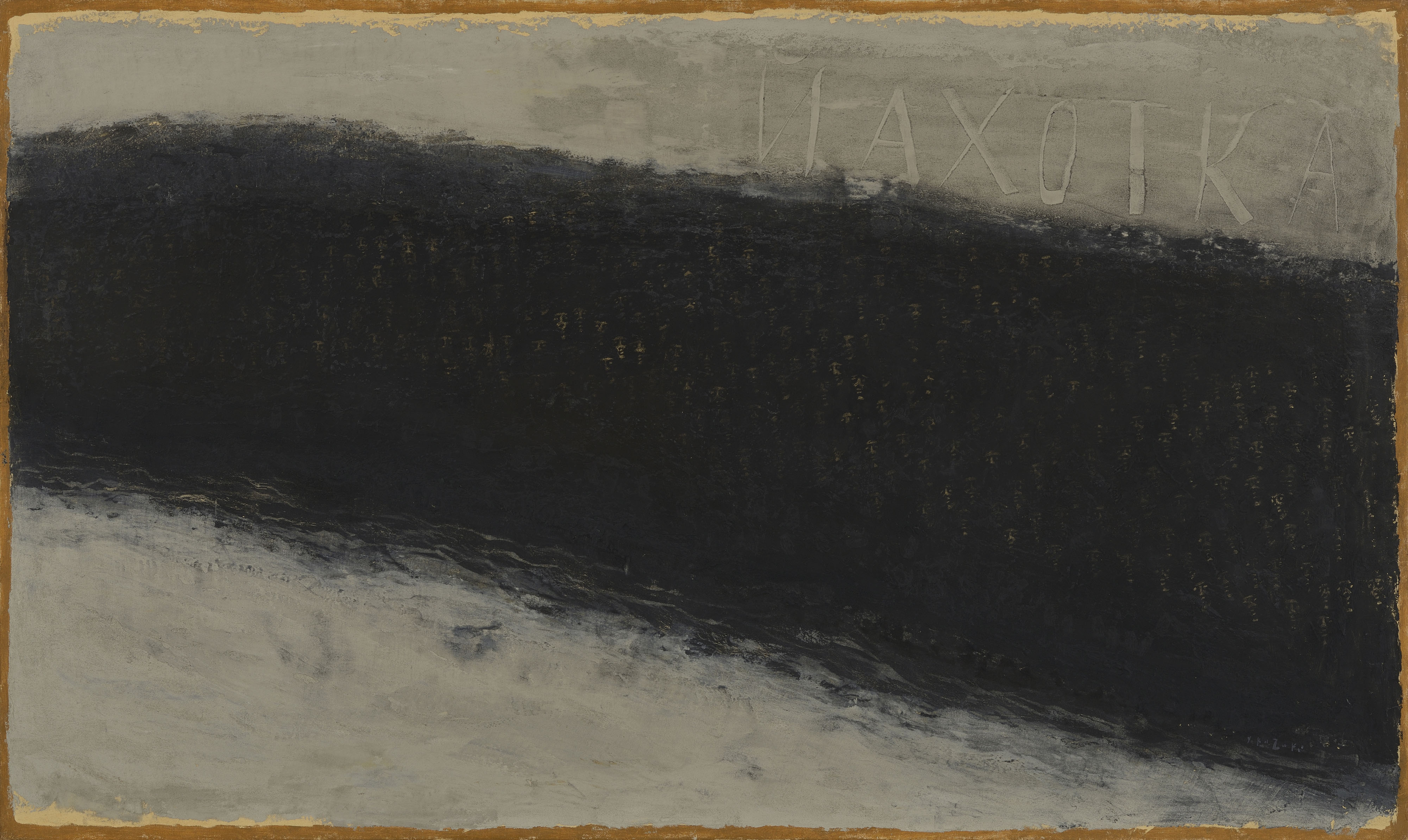
なぎさ(なほとか) 渚〈ナホトカ〉
1974(昭和49年)
油彩/カンヴァス
〈作品解説〉
シベリアに抑留されてから1年半後、日本への帰国が決まり、香月たちは日本海沿岸の港町ナホトカにたどり着きました。画面右上の文字は「ナホトカ」と読めます。日本海の白波が打ち寄せる浜辺で一晩過ごした時の情景が、この絵には描かれています。
画面を横切る黒い帯のなかには、よく見ると無数の顔が描かれています。どの顔もうつろな目つきで、身を寄せ合って眠っているかのよう。彼らは生きて日本に帰り着くことができた抑留者たちですが、香月はそこに故国へ帰ることが叶わなかった同胞の姿が重なった、と記しています。
この絵はシベリア・シリーズ最後の一枚であり、香月が急逝した時、アトリエのイーゼルに掛けられていました。晩年の香月にとって、最後まで心を離れなかったのは、帰国を待ち望んだ抑留者としての日々と、その夢を果せなかった同胞たちの無念の思いが充満しているような、このナホトカの浜辺の情景だったのでしょうか。
〈画家のことば〉
1947年5月初旬、私達はナホトカの渚に下車、漸くたどり着いたと言えよう。
ああ、この塩辛い水の繋がる向う岸に日本があるのかと舌でたしかめたものだ。
私たちは一晩砂浜で寝た。その時の情景を描いた積りだが、何だか日本の土を踏むことなくシベリヤの土になった人達の顔、顔を描いているような気がしてならぬ。
20数年経った今の、単なる私の感傷であろうか。
『遺作による香月泰男展』図録(日本橋髙島屋ほか、1974年)
香月泰男【かづき やすお】
生没年 1911~1974(明治44年~昭和49年)
山口県大津郡三隅村(現・長門市三隅)に生まれた香月泰男は、東京美術学校で油彩画を学び、美術教員の傍ら国画会を中心に作品を発表しました。1967年、太平洋戦争への従軍と戦後のシベリア抑留の経験を描いた「シベリア・シリーズ」により、第一回日本芸術大賞を受賞。その作品は今日も多くの人々を惹きつけています。
| 寸法 | 96.5×162.0cm |
|---|---|
| 形状 | 額装 |

Beach "Nakhodka"
1974
Oil on canvas
〈Commentaries on works on display 〉
After one year and a half of internment in Siberia, Kazuki and the other Japanese soldiers are finally heading home. They arrive at the town of Nakhodka, on the coast of the Japan Sea. The name of the town can be seen at the top right of this work, which depicts the evening spent on the beach, with foam-crested waves from the Japan Sea breaking on the shore.
Closer inspection of the black stripe across the middle of the canvas reveals countless faces within. Their eyes are hollow and they are huddled together as if sleeping. These are the soldiers who survived long enough to make it back to Japan, although Kazuki notes he has overlaid the images of the many who did not.
This is the last work in the Siberia Series. It was still mounted on the easel in his atelier at the time of his sudden passing. In his later years, Kazuki was never able to resolve his feelings about his having returned home safely while so many of his comrades were unable to realize their homecoming dream. No doubt this was part of the inspiration behind Beach at Nakhodka.
〈Painter’s words〉
In early May of 1947 we got off the train at Nakhodka. Finally, we had arrived! I tasted the salty water on my tongue, knowing that it was my direct connection to the homeland, just over there on the other side of the Japan Sea.
We slept on the beach that night, and that’s what I wanted to paint in this picture. And yet, I could not free myself from the faces of all those who perished in Siberia before they were able to once again set foot in their own country.
I have a feeling that this painting simply expresses my raw feelings 20 years on.
Catalog of the exhibition Kazuki Yasuo Exhibition of his posthumous works (Nihonbashi Takashimaya and others, 1974)
Kazuki Yasuo 1911 – 1974
Born in Misumi-mura (now Misumi, Nagato City) in Otsu-gun, Yamaguchi Prefecture. Studied oil painting at Tokyo School of Fine Arts, then taught fine art while producing works that were primarily exhibited at Kokugakai (National Painting Association). Kazuki was sent to fight in the Pacific War (WWII), then interned in Siberia after the war. This experience resulted in the Siberia Series, which won the inaugural Japan Art Grand Prize in 1967. This series is considered an important body of work that still resonates widely today.
| Size | 96.5×162.0cm |
|---|

渚(納霍德卡)
1974
《作品解說》
在西伯利亞被拘留一年半後,終於可以返回日本,香月等人來到了日本海沿岸的港口城市納霍德卡。畫麵右上方的文字讀作“nahotoka”。這幅畫描繪了在白浪拍打的日本海邊度過一晚的情景。
細看橫貫畫麵的黑色條帶,其中描畫著無數張臉。每張臉都眼神空洞,仿佛彼此依靠著睡著了一樣。他們是幸存的回到日本的被拘留者,但香月記錄著,這裏也重疊著無法回到故土的同胞的身影。
此畫是西伯利亞係列的最後一幅,香月突然離世時,就掛在畫室的畫架上。對於晚年的香月來說,始終縈繞在心頭的,可能就是納霍德卡海邊的情景吧,那裏充斥著期盼回國的被拘留者的日日夜夜,以及無法實現夢想的同胞們的遺憾。
《畫家的話》
1947年5月上旬,我們在納霍德卡的岸邊下車,可以說我們終於到達了。
啊,這鹹鹹的海水連接的對岸就是日本啊,我不禁用舌頭確認了一下。
我們在沙灘上睡了一晚上。雖然隻是描畫當時的情景,但我總覺得,仿佛畫的是那些沒有踏上日本國土,就已變成西伯利亞土地的人們的面孔。
20多年後的今天,也隻是我單純的感傷嗎。
《香月泰男遺作展》圖錄(日本橋高島屋等,1974年)
香月泰男
生卒年 1911~1974(明治44年~昭和49年)
香月泰男出生於山口縣大津郡三隅村(現長門市三隅),在東京美術學校學習油畫,在擔任美術教員的同時,主要在國畫會發表作品。1967年, “西伯利亞係列 “獲得了第一屆日本藝術大獎,描繪了香月在太平洋戰爭中服役以及戰後被關押在西伯利亞的經曆。那些作品至今也受很多人歡迎。
| 尺寸 | 96.5×162.0cm |
|---|

물가(나홋카)
1974
시베리아에 억류된 지 1년반, 일본으로의 귀국이 결정되어 가즈키와 동료들은 동해에 면한 항구마을 나홋카에 도착하게 됩니다. 화면 오른쪽 상단의 글씨는 「나홋카」라 읽습니다. 동해의 흰 파도가 밀려오는 바닷가에서 하룻밤을 보낸 당시의 정경이 이 그림에 그려져 있습니다.
화폭을 가로지르는 검은 띠 안에는 무수히 많은 얼굴이 그려져 있습니다. 모두 얼빠진 눈을 하고 몸을 모아 맞대고 잠들어 있는 듯합니다. 그들은 살아서 일본에 돌아갈 수 있게 된 포로들이지만, 가즈키는 그 곳에 고국에 돌아올 수 없는 이 세상을 떠난 동포들의 모습이 겹쳐졌다, 고 기록합니다.
이 작품은 시베리아 시리즈의 마지막 작품이며, 가즈키가 갑자기 생을 달리하게 된 당시 아틀리에의 이젤에 놓여져 있던 작품이기도 합니다. 만년의 가즈키에게 있어서 마지막까지 그를 붙잡았던 것은 귀국을 기다리고 희망하던 포로로서의 날들과, 그 꿈을 이루지 못한 동포들의 원통함이 가득찬 이 나홋카 바닷가의 정경이었을까요.
가즈키 야스오
생몰년 1911~1974 (메이지44년~쇼와49년)
야마구치현 오오츠군 미스미(현 나가토시 미스미)에서 태어난 가즈키 야스오는, 도쿄 미술학교에서 유화를 공부하고, 미술 선생님으로 재직하는 한편, 당시 일본 유력 미술 단체 중 하나인 국화회를 중심으로 작품을 발표했습니다. 1967년, 태평양 전쟁에서의 종군 생활과 전쟁 후의 시베리아 억류 경험을 그린 「시베리아 시리즈」를 통해 제1회 일본 예술 대상을 수상. 그 작품은 현재까지도 많은 사람들을 매혹시키고 있습니다.
| 치수 | 96.5×162.0cm |
|---|
